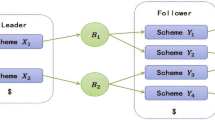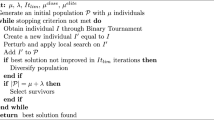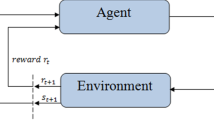Abstract
We study a game theoretical model of multistage interval scheduling problems in which each job consists of exactly one task (interval) for each of t stages (machines). In the game theoretical model, the machine of each stage is controlled by a different selfish player who wants to maximize her total profit, where the profit for scheduling the task of a job j is a fraction of the weight of the job that is determined by the set of players that also schedule their corresponding task of job j. We provide criteria for the existence of pure Nash equilibria and prove bounds on the Price of Anarchy and the Price of Stability for different social welfare functions.








Similar content being viewed by others

Notes
Here, each patient corresponds to a job that has to be scheduled for several consecutive treatments (stages) on a clinical pathway (if the job is accepted) or sent to another hospital (if the job is rejected).
Alternatively, one can consider the setting in which each player only knows about the release dates and processing requirements of the tasks of her own stage. All our results can easily be seen to hold in both settings.
In Sect. 5, we consider reward functions that are also job-dependent.
References
Andelman, N., Azar, Y., & Sorani, M. (2005). Truthful approximation mechanisms for scheduling selfish related machines. In Proceedings of the 22nd international symposium on theoretical aspects of computer science (STACS), volume 3404 of LNCS (pp. 69–82).
Andelman, N., Feldman, M., & Mansour, Y. (2007). Strong price of anarchy. In Proceedings of the 18th ACM-SIAM symposium on discrete algorithms (SODA) (pp. 189–198).
Archer, A., & Tardos, É. (2001). Truthful mechanisms for one-parameter agents. In Proceedings of the 42nd annual IEEE symposium on the foundations of computer science (FOCS) (pp. 482–491).
Arkin, E. M., & Silverberg, E. B. (1987). Scheduling jobs with fixed start and end times. Discrete Applied Mathematics, 18(1), 1–8.
Auletta, V., De Prisco, R., Penna, P., & Persiano, G. (2004). Deterministic truthful approximation mechanisms for scheduling related machines. In Proceedings of the 21st international symposium on theoretical aspects of computer science (STACS), volume 2996 of LNCS (pp. 608–619).
Bouzina, K. I., & Emmons, H. (1996). Interval scheduling on identical machines. Journal of Global Optimization, 9(3–4), 379–393.
Brucker, P. (2007). Scheduling algorithms (5th ed.). Berlin: Springer.
Canetti, R., & Irani, S. (1998). Bounding the power of preemption in randomized scheduling. SIAM Journal on Computing, 27(4), 993–1015.
Carlisle, M. C., & Lloyd, E. L. (1995). On the \(k\)-coloring of intervals. Discrete Applied Mathematics, 59(3), 225–235.
Christodoulou, G., Koutsoupias, E., & Nanavati, A. (2004). Coordination mechanisms. In International colloquium on automata languages and programming (ICALP) (pp. 345–357).
Cohen, J., Dürr, C., & Nguyen, K. T. (2011). Non-clairvoyant scheduling games. Theory of Computing Systems, 49(1), 3–23.
Czumaj, A., & Vöcking, B. (2009). Tight bounds for worst-case equilibria. ACM Transactions on Algorithms, 3(1), 1–17.
Epstein, L., & Kleiman, E. (2014). Scheduling selfish jobs on multidimensional parallel machines. In Proceedings of the 26th annual acm symposium on parallelism in algorithms and architectures (SPAA) (pp. 108–117).
Epstein, L., & van Stee, R. (2012). The price of anarchy on uniformly related machines revisited. Information and Computation, 212, 37–54.
Faigle, U., & Nawjin, W. M. (1995). Note on scheduling intervals online. Discrete Applied Mathematics, 58(1), 13–17.
Hopf, M., Thielen, C., & Wendt, O. (2017). Competitive algorithms for multistage online scheduling. European Journal of Operational Research, 17(2), 468–481.
Kolen, A. W. J., Lenstra, J. K., Papadimitriou, C., & Spieksma, F. C. R. (2007). Interval scheduling: A survey. Naval Research Logistics, 54, 530–543.
Koutsoupias, E., & Papadimitriou, C. (1999). Worst-case equilibria. In Proceedings of the 16th international symposium on theoretical aspects of computer science (STACS)
Kovács, A. (2005). Fast monotone 3-approximation algorithm for scheduling related machines. In Proceedings of the 13th annual european symposium on algorithms (ESA), volume 3669 of LNCS (pp. 616–627).
Kovalyov, M. Y., Ng, C. T., & Cheng, T. C. E. (2007). Fixed interval scheduling: Models, applications, computational complexity and algorithms. European Journal of Operational Research, 178(2), 331–342.
Monderer, D., & Shapley, L. S. (1996). Potential games. Games and Economic Behavior, 14, 124–143.
Nash, J. (1951). Non-cooperative games. Annals of Mathematics, 54(2), 286–295.
Nisan, N., Roughgarden, T., Tardos, É., & Vazirani, V. V. (Eds.). (2007). Algorithmic Game Theory. Cambridge University Press.
Rosenthal, R. W. (1973). A class of games possessing pure-strategy Nash equilibria. International Journal of Game Theory, 2(1), 65–67.
Thielen, C., & Krumke, S. O. (2008) A general scheme for designing monotone algorithms for scheduling problems with precedence constraints. In Proceedings of the 6th workshop on approximation and online algorithms (WAOA), volume 5426 of LNCS (pp. 105–118).
Woeginger, G. J. (1994). Online scheduling of jobs with fixed start and end times. Theoretical Computer Science, 130(1), 5–16.
Author information
Authors and Affiliations
Corresponding author
Appendix
Appendix
1.1 Payoff matrices
We present the payoff matrices for the examples in Lemmas 1 and 2 (Tables 1, 2).
1.2 Proofs of Theorem 9 and Theorem 10
We now present the proofs of Theorems 9 and 10.
Proof of Theorem 9
Let \(\varGamma =\varGamma (N,J,(\alpha _j)_j)\) be a MISG with job-dependent rewards. If \(\vert J\vert = 1\), the statement is trivial. If \(\vert J\vert \geqslant 2\), we construct a MISG \(\overline{\varGamma }=\overline{\varGamma }(\overline{N},\overline{J},\overline{\alpha })\) with job-independent rewards as follows: For each job \(j\in J\), we create a new player, i.e., \(\overline{N} :=N \dot{\cup } J\) and \(\overline{t} :=t + \vert J \vert \), and the set of jobs is given as \(\overline{J}:=J \cup \{M\}\), where M denotes a job with such a large weight that it is always beneficial for every player to include it in her schedule. The weight of each job \(j\in \overline{J} \;\setminus \{M\}\) is set to \(\overline{w}_j :=1+\max _{A\subseteq N} \max _{i\in A} \alpha _j(i,A)\). The reward function \(\overline{\alpha }\) of \(\overline{\varGamma }\) is defined by setting
Note that, by definition of the weights \(\overline{w}_j\), \(\overline{\alpha }\) takes values in [0, 1]. The intersections of all jobs for the players in N (the original players) remain the same, and the additional job M is presented such that its tasks do not intersect with any other tasks. The intersections for a new player \(i\in \overline{N} \setminus N\) are as shown in Fig. 9, so that her optimal schedule is always \(\overline{S}_i = \{i,M\}\).
We define a mapping \(f:\pmb {S}\rightarrow \pmb {\overline{S}}\) from the set of schedules of \(\varGamma \) to the set of schedules of \(\overline{\varGamma }\) by setting
Hence, the schedules of the original players are just complemented by the job M and do not change otherwise, and the schedule of each new player \(i\in J= \overline{N}\setminus N\) is set to \(\{i,M\}\). Thus, f is obviously injective.
Let \(\text {NE}(\varGamma )\) and \(\text {NE}(\overline{\varGamma })\) denote the sets of all pure NEs of \(\varGamma \) and \(\overline{\varGamma }\), respectively. We now show that the restriction \(f\vert _{\text {NE}(\varGamma )}: \text {NE}(\varGamma )\rightarrow \text {NE}(\overline{\varGamma })\) is well-defined and surjective, which implies that \(f\vert _{\text {NE}(\varGamma )}\) is a bijection and, thus, shows the claim.
If S is a NE of \(\varGamma \), then f(S) is a NE of \(\overline{\varGamma }\) because an original player clearly cannot improve her schedule and, as argued above, the schedule \(\{i,M\}\) is optimal for a player \(i\in J = \overline{N}\setminus N\).
Now let \(\overline{S}\) be a NE of \(\overline{\varGamma }\). As argued above, each player \(i\in J=\overline{N}\setminus N\) adopts the schedule \(\overline{S}_i=\{i,M\}\). Hence, \(\vert A_M^{\overline{S}} \vert \geqslant \vert J \vert \geqslant 2\), so \(\overline{\alpha }(i,A_M^{\overline{S}}) = 1\) for all players \(i\in N\). Thus, the job M must also be contained in every schedule \(\overline{S}_i\) for \(i\in N\). Consequently, the schedule S of \(\varGamma \) defined by setting \(S_i :=\overline{S}_i \setminus \{M\}\) for all \(i\in N\) satisfies \(f(S) = \overline{S}\) and is a NE of \(\varGamma \). \(\square \)
Proof of Theorem 10
Given a MISG \(\varGamma \) with restricted availabilities, we construct a MISG \(\overline{\varGamma }\) with job-dependent rewards as follows: We just introduce a new job M with such a large weight M that it is always beneficial to include it in a schedule. Therefore, we set \(\alpha _M(i,A) :=C\) for all \(A\subseteq N\) and \(i \in A\), where C is a large constant (\(C> t\cdot \vert J \vert \cdot \max _{j\in J}\max _{A\subseteq N}\max _{i\in A}\alpha _j(i,A)\)). In \(\overline{\varGamma }\), for player i, all intersections of the tasks in \(J_i\) remain the same as for the original instance. Moreover, we present job M such that it does not intersect with any job from \(J_i\). Finally, we present all jobs in \(J\setminus J_i\) directly above job M such that they are never included in a dominant schedule.
We define a mapping \(g:\pmb {S} \rightarrow \pmb {\overline{S}}\) by setting
In particular, the schedule \(g(S)_i\) of player i in \(\overline{\varGamma }\) is now \(S_i \cup \{M\}\).
Now, we can argue analogously to the proof of Theorem 9 to show that the restriction \(g_{\vert NE(\varGamma )}: \text {NE}(\varGamma ) \rightarrow \text {NE}(\overline{\varGamma })\) is a bijection. This follows since the intersections of the available tasks remain the same for each player and the utilities change only by an additive constant. \(\square \)
Rights and permissions
About this article
Cite this article
Herzel, A., Hopf, M. & Thielen, C. Multistage interval scheduling games. J Sched 22, 359–377 (2019). https://doi.org/10.1007/s10951-018-0568-y
Published:
Issue Date:
DOI: https://doi.org/10.1007/s10951-018-0568-y




